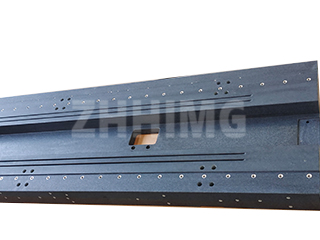A granite precision platform, with its inherent stability and dimensional accuracy, forms the foundation of high-level metrology and assembly tasks. For many complex applications, however, a simple flat surface isn’t enough; the ability to securely and repeatably clamp components is vital. This is where the integration of T-slots comes into play. Understanding how T-slot size and spacing align with clamping requirements is the key to maximizing your platform’s utility without compromising its renowned precision.
The Clamping Challenge: Balancing Force and Accuracy
Unlike cast iron tables where T-slots are directly machined into the structural metal, T-slots in a granite surface plate are typically achieved by recessing and inserting specialized steel T-bars or channels into the stone. This engineering choice is driven by the need to maintain the granite’s structural integrity and micro-flatness.
The core challenge lies in the dual nature of the T-slot: it must provide a robust anchor for substantial clamping force while ensuring that this force does not induce deflection or localized stress into the underlying granite that would destroy the plate’s calibration.
T-Slot Size: Driven by Standard and Clamping Force
The selection of the T-slot width is not arbitrary; it follows established international standards, most commonly DIN 650 or popular metric and SAE sizes. This standardization ensures compatibility with a vast range of industrial clamping tools, T-nuts, vises, and fixture components.
- Size (Width): The nominal width of the T-slot directly determines the size of the T-nut and the corresponding clamping bolt that can be used. Larger clamping bolts naturally generate higher axial forces. Therefore, the T-slot size (e.g., 14mm, 18mm, or 22mm) should be chosen based on the anticipated maximum clamping force required for your heaviest or most demanding fixturing needs. Manufacturers often offer T-slots with tighter width tolerances, such as H7 or H8, for applications demanding high-precision guiding or alignment in addition to clamping.
- Depth and Strength: For applications requiring extremely high pull-out loads, manufacturers can increase the depth of the steel T-slot insert. The maximum pull-out strength of the T-slot assembly—the force required to tear the insert from the granite—is ultimately determined by the strength of the clamping bolt and the robust epoxy bonding used to secure the steel insert into the granite groove.
The Significance of Spacing
The spacing of the T-slots—that is, the distance between parallel slots—is critical for providing flexible and balanced clamping across the entire work area.
- Fixture Versatility: A denser grid of T-slots or a combination of T-slots and threaded inserts (tapped holes) provides greater flexibility for positioning irregular workpieces and custom fixtures. This is essential for metrology labs and assembly areas dealing with a wide variety of parts.
- Load Distribution: Proper spacing allows a user to distribute the necessary clamping force over multiple points. This prevents localized stress concentrations that could lead to surface distortion (deflection) in the granite platform. When heavy or irregularly shaped parts are clamped, using widely spaced anchors ensures the load is spread out, maintaining the granite’s overall flatness within its specified tolerance.
- Guiding Applications: T-slots aren’t just for clamping; they can also be used as guide bars for mounting alignment tools like tail stocks or balance stands. In these cases, the spacing often aligns with the equipment’s base dimensions to ensure stable, parallel motion.
Customization is Key
For true precision applications, such as large CMM bases or complex optical assembly tables, the T-slot configuration is nearly always custom-engineered. A precision platform supplier, like our team at ZhongHui, will collaborate with you to define the optimal layout based on:
- Workpiece Size and Weight: The dimensions of your largest component dictate the necessary coverage and structural support.
- Required Clamping Force: This defines the T-slot size and the steel insert’s robust construction.
- Required Accuracy Grade: Higher precision grades (like Grade 00 or 000) demand a more careful design to ensure the clamping mechanics do not introduce micro-deformations.
In summary, the T-slot in a granite platform is a carefully engineered interface. It adheres to standards like DIN 650 for compatibility, and its dimensions and layout must be meticulously chosen to provide the secure fixturing you need without compromising the very quality—ultimate flatness and stability—that makes the granite platform essential to your metrology operation.
Post time: Oct-14-2025

